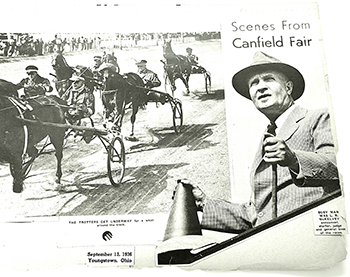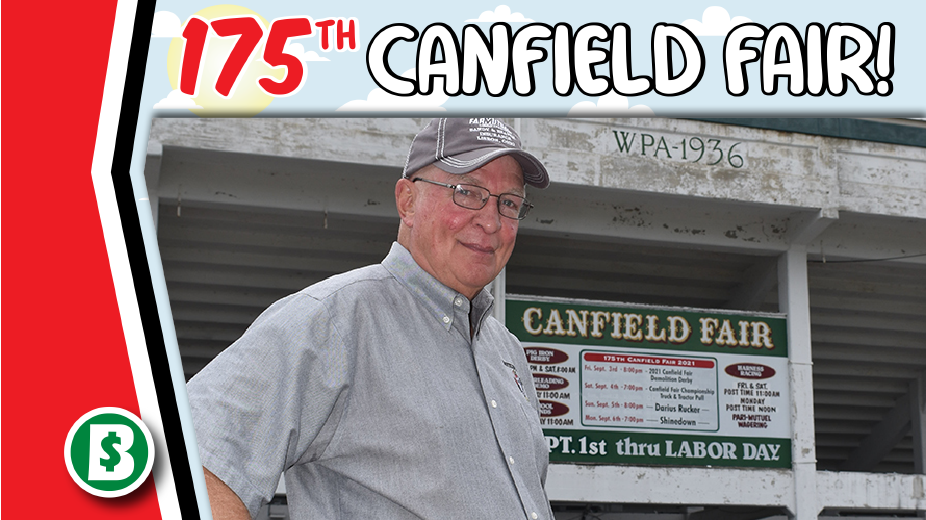CANFIELD, Ohio – During its 175-year history, the Canfield Fair has enjoyed physical growth and expanded its attractions and focuses. It’s even been visited by no fewer than four future U.S. presidents.
Even though the role of agriculture at the fair has declined to 40% from about double that in the early years, at its core the annual event remains a showcase of local agriculture, says Elwood “Woody” Woolman, a member of the Canfield Fair Board of Directors and a former member of the Columbiana County Fair board.
“We don’t look at the fair as a carnival. We look at it as an agricultural fair,” Woolman says.
The former schoolteacher, on the fair board since 2015, has been involved with the Canfield Fair for 57 years, since he was 9 years old. He had a saddle horse project when he was a member of Berlin Boots & Saddles 4-H.
The history of the fair, which will be documented on a series of signs placed along the fairgrounds to commemorate the 175th edition, began with the first fair of the Mahoning County Agricultural Society in 1846, held on the Canfield Village Green. Exhibitors brought their best apples, corn, squashes, cattle, sheep and pigs for display, competing for ribbons and awards much as they do today.
After three years, the farmers decided to establish a permanent location for the fair, which was “infringing on other things that were happening on the village green,” Woolman says. The society bought five acres near what is now the main entrance at Gate 5, with more land added over the years to increase the size of the fairgrounds to more than 350 acres today.
The fair continued to grow as farmers, breeders and livestock exhibitors from nearby counties participated in the annual event “because of the prestige of competing with the other farmers here in Mahoning County,” says Bill Lawson, executive director of the Mahoning Valley Historical Society.
The “carnival atmosphere” also progressed from the early years of the fair as it added more entertainment and shows, including a dancing bear, tugs of war and other competitions, Woolman says. In 1883, the first racetrack was built.
“Then with that came food stands,” he says, and other entertainment such as games of chance.
A second racetrack was built in 1926, the grandstand in 1932 and expanded in 1936 as a Works Progress Administration project during the Great Depression.
“It’s a huge grandstand when you compare it to other county fairs,” he says. Demolition derbies, tractor pulls and concerts joined harness racing over the years as grandstand show mainstays.
The Depression also led to expanded use of the fair by commercial businesses as a vehicle to showcase their products and services.
“People were doing everything they could to promote whatever commercial business they could and this was a good place to do it,” Woolman says. “If I’ve got a business, I’m doing everything I can to make sure that I get that out there. And this was as big of an event in the county as they had.”
Exhibiting at the fair was “cheaper than advertising in the newspaper,” Lawson says. Car dealers joined dealers of farm equipment on the fairgrounds. Nearly any household item someone wanted would be represented in some form.
“There would always be dealers and manufacturers there but at some point it became much more sophisticated,” Lawson says. “As the audience grew, the desire of these companies to be represented would have gone up with it.”
Another aspect of the fair that would grow over the years is its popularity as a venue for politicians, whether they served at the local, state or federal level.
Since the early years of the fair, it has been “an important place to stump,” Woolman says.
In addition to the candidates for governor, U.S. senator and congressman, as well as local offices, four future presidents have visited the fairgrounds, including two in the same year.
“That doesn’t sound like a lot. But it is,” he says. “We’re especially proud of that.”

William McKinley visited the fair when he ran for governor, as did another future president, Warren G. Harding. After stopping by in 1920, Harding declared the fair was “the most wonderful institution in the country,” Woolman says.
Two future presidents appeared at the 2016 Canfield Fair. Donald Trump’s visit on Labor Day, when he was interviewed by ABC News in the fairgrounds administration building, followed a visit a few days earlier by then-Vice President Joe Biden, who stopped by after a rally in support of the Democratic nominee, Hillary Clinton.
President Richard Nixon was invited to the fair in 1970 but did not accept.
“It’s a natural for politicians because you get in with the people and you press the flesh,” Lawson says. “You let people know that you’re there for them.” That the fair is about two months before the general election is important.
The role of the fair as a venue for popular performing artists began in the 1950s, with Red Skelton and the Lennon Sisters, Woolman says. Over the years, they were followed by performers such as Bob Hope, Willie Nelson, Chubby Checker, Kenny Loggins, The Judds, Helen Reddy, Dolly Parton, The Beach Boys and, this year, Shinedown and Darius Rucker.
Although the role of agriculture in the fair today is smaller, Woolman sees the shift as positive, because agriculture remains its focus.
“We can only do with what we’ve got. There’s fewer farmers today but yet [agriculture] is still an important part of the fair and we devote a huge amount of energy toward making that the best that it can be,” he says.
From its early years, the fair grew to an event that in the 20th century catapulted it to be a “big leader” in Ohio, attracting some 250,000 or more each year, Lawson says.
It is reportedly the second-largest fair in Ohio, exceeded only by the Ohio State Fair, and is the largest county fair in the state.
“It is definitely very important in terms of spending several days in the barns or at the fair, meeting up with neighbors from the larger region,” Lawson says. “There’s definitely a very strong and important social context for this fair and all agricultural exhibitions.”
“When you talk about the Mahoning Valley, you cannot separate the Canfield Fair from that talk. It encompasses everybody,” Woolman says. “There’s very few people in this county who either have not been here or do not know about it. It’s probably got the best name recognition of any institution in the Valley.”
Pictured at top: Elwood Woolman, a member of the fair board, stands in front of the grandstand, built in 1932 and expanded in 1936 by the Works Progress Administration.
